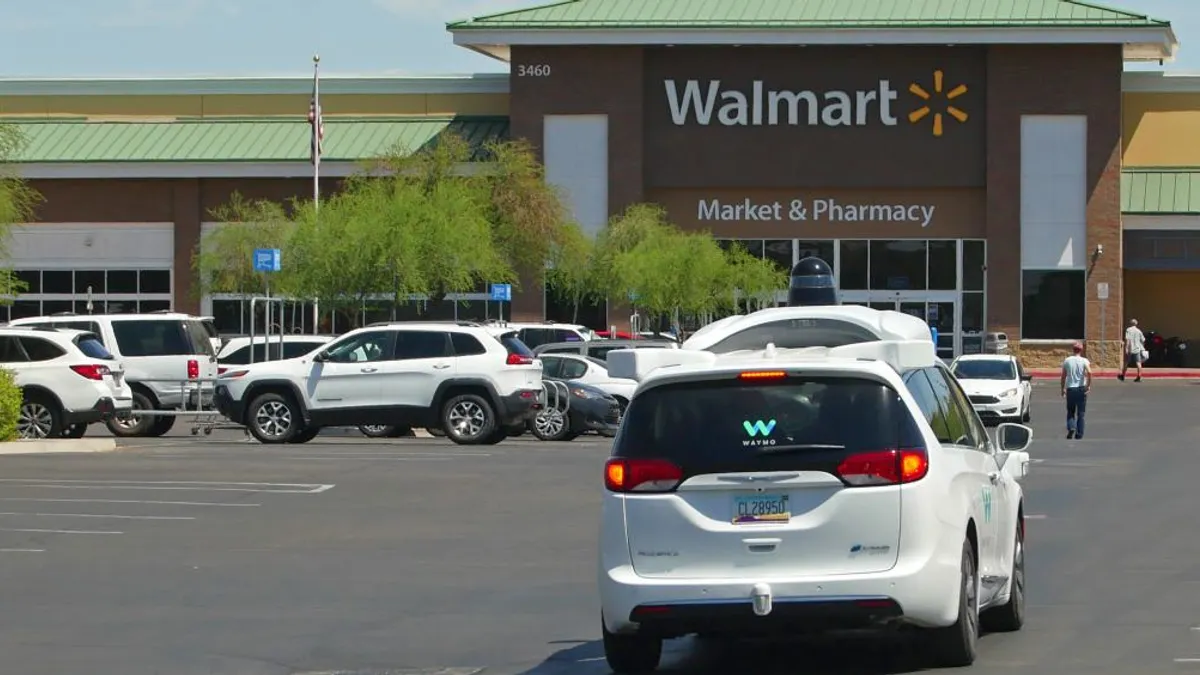Dive Brief:
- Walmart could surpass Amazon as online grocery leader thanks to its continued expansion of store pickup and home delivery, according to a report from Deutsche Bank analyst Paul Trussell.
- Over the long run, Trussell sees Amazon claiming dominance in e-grocery, with 19% market share predicted by 2025 (up from a current 13%) compared to Walmart’s estimated 17% (up from 11%). The analyst sees Instacart claiming a 19% share by 2025 while Kroger and Target are predicted to be at 7% and 2%, respectively. Overall, Trussell sees continuing bifurcation in online grocery: Large players with the ability to invest in services and navigate complex operations will gain market share from smaller, less differentiated competitors.
- Trussell estimates that online grocery will grow from 3% of sales currently to 12% by 2025, or $120 billion, reflecting compound annual growth of 28%. He predicts the channel will surpass $100 billion in sales by 2023 or early 2024.
Dive Insight:
In addition to store delivery and pickup, Walmart is investing in innovations like pickup towers, automated order fulfillment and driverless technology. The company is also seeking patents on some far-out technology that illustrate a willingness to look beyond the market’s growth curve and own key aspects of the customer experience.
Innovations like this will drive customer demand for online grocery, according to the Deutsche Bank report. As e-commerce becomes easier and more engaging — not to mention cheaper — more and more people will want to have companies do their shopping for them. And when they do, market leaders like Walmart, Amazon and Instacart will be waiting for them.
With market share going to the largest, richest companies in the industry, online grocery is shaping up to be a two-horse race between Amazon and Walmart. Here, Walmart has taken so many right steps, from the rapid build-out of store pickup to its decision to partner with on-demand companies for expensive last-mile fulfillment. Meanwhile, significant parts of Amazon’s online business have struggled, from the tepid growth of AmazonFresh to its underwhelming private label food and beverage lineup, and questions linger over how, exactly, Amazon will piece together its many offerings.
But Amazon is famous for being unhurried in its push towards category dominance. Despite its struggles, the e-tailer remains the leader in online grocery sales. It also has world-class innovation capabilities and a nationwide network of Whole Foods stores and distribution centers that will serve as the backbone for its ongoing expansion. As voice ordering continues to evolve, Amazon best-positioned to capitalize on its Alexa technology. It’s also hard at work building its private brand portfolio. And the industry should prepare for AmazonFresh to come roaring back, particularly as other pure-play competitors, like Peapod, struggle with scale and operations.
What about traditional retailers like Kroger, Albertsons and Ahold Delhaize? Trussell is less bullish on their prospects. Kroger, he notes, has made a lot of the right moves with recent investments in automation, new formats and direct-to-consumer sales channels. But these moves will weigh heavily on the company’s top line as it continues to face margin pressure. Trussell downgraded Kroger’s stock from “hold” to “sell,” with a price target of $24 per share.
“It will likely be quite challenging to grow profits while playing from a position of weakness, and so we are now modeling operating income falling well short of current targets,” he wrote in the report.
Albertsons and Ahold Delhaize, Trussell notes, are not differentiated enough from these top competitors and as such will concede online market share over the coming years. Ahold Delhaize has begun integrating Peapod — the company’s pure-play online grocer — further into store fulfillment, but the service has struggled with a lack of investment and innovation, according to analysts interviewed by Food Dive.
The biggest share donors, Trussell believes, will be regional and independent grocers that don’t have the money to build out their operations and differentiate from the competition. The fact that these players are already facing intense pressure on their store operations means that e-commerce, rather than a growth opportunity, will likely only put them further behind.
“We suspect that the gulf between the leaders and the laggards will only widen ahead,” Trussell wrote.













